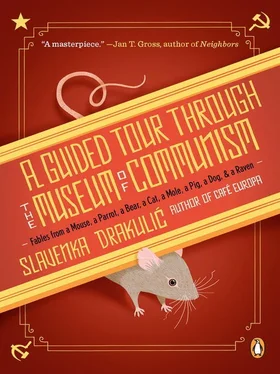Obviously, you had either bananas or “socialism”; the two of them didn’t grow together. But what was this socialism ? “Another kind of food?” I asked myself. Based on available sources, I soon came to the conclusion that socialism must have been not food but a kind of pestilence that prevented bananas from growing in the Eastern part of the Overland.
I have to admit that the Legend about the Berlin Wall is still cryptic and confusing concerning some crucial points. But, as Andreas would say, so is most of what goes on in the Overland. In trying to think logically about this enigma of bananas—and logic is what we Moles care most about—it seemed that Men on the nonbanana side of the Wall (although I have to remind myself it would be proper to use the plural here) did everything in their rather limited power to reach the banana side. To achieve that aim they had to fight both an internal enemy, such as fear, as well as external ones, i.e., guards and the Stasi. The reason for this seems to be that Men were going crazy about these fantastic and—due to the pestilence—rare earthworms. Again, if I were to pursue a Mole’s line of reasoning, I would have to conclude that Men built the Wall(s) in order to protect themselves from that pestilence called socialism that was on the Eastern side. But the Legend tells us just the opposite! Those who built the Wall(s) were those marked by pestilence and the lack of bananas—so what were they protecting?
After having pondered a while, I thought that there could be only one answer: The Men on the nonbanana side built the Wall(s) to protect the prisoners and bananas from socialism. They surely demonstrated extraordinary care for the others, a noble characteristic of human beings. Regrettably, I cannot claim that we Moles would have done the same.
Then I had to look for Andreas again, as the two of us had another logical problem to solve. “If the building of the Berlin Wall(s) was really a protective measure against pestilence, as I believe it was, why would somebody infected by socialism try to escape into the prison, risking infecting the prisoners? Would that not be extremely irresponsible behavior? By the way, I suppose this banana hunt is the only known case of a population trying to break into a prison, not out of one,” I told him. But this time he was not very helpful. “There is not much hope that a Mole—that logical, rational creature—would ever be able to completely understand irrational, emotional, confused human beings and their deeds, Tillman,” Andreas nodded. I was not satisfied with such an abstract answer. “Isn’t it bizarre that prisoners on the banana side claimed that they were free, while those on the nonbanana side tried to jump over the Wall(s), or crawl under them, just because of their wish to move and eat freely within the prison? Again, here we have the unique case of prisoners claiming they feel free,” I insisted.
“It is not as bewildering as you believe,” Andreas said. “Imagine that you live in a territory you call a prison, but you have the possibility to get out of it if you wish, passing through—never mind how!—a tiny strip of land in the foreign territory populated by the enemy. You are not a prisoner because you can leave whenever you want. Isn’t that so?” “Yes, indeed,” I had to admit. “West Berlin was such a place,” Andreas said. “Although half the city was within foreign territory, it was still connected to a bigger, free one.” He did not explain any more about that free world, but it was a bit clearer to me why Men wanted to escape and ended up first in the prison, which was not a prison because, in the strict sense of the word, you could leave it by certain restricted routes. “And what were they searching for even beyond that West Berlin prison?” I asked Andreas. “More succulent earthworms, of course!” he replied.
After that I had no other option but to conclude that, in these ancient times of the Wall(s), what Men defined as freedom was moving from one banana place to another.
In my further research into this Legend, which more and more seemed to me to be based upon at least some historical facts, I learned that, indeed, there are further proofs of the strange behavior of Men. I mean, material evidence that cannot be disputed. For example, Men had other means of getting out of the nonbanana part of Berlin, not only through tunnels as I had thought at the beginning. They would also fly off in a birdlike machine. Or escape in a fishlike machine, if one preferred diving to flying. I heard from one Mole, who knows a Mole, who knows another Mole who heard about a Man flying such a machine, which resembles an eagle (we know a bit about that cursed marauder, the archenemy of our rabbit friends). Starting from a far-off banana place, he landed in a field in the nonbanana Overland. There his sweetheart was waiting for him. He grabbed her, as an eagle would have grabbed an unlucky Mole, and flew away with her into the sunset—as Men would probably have put it poetically. Presumably, they lived happily ever after, but this supposition belongs more to the realm of fairy tales, not to my research.
Then something occurred that made me completely change my mind about what the Legend is and what the real story is, i.e., history.
One of my acquaintances was recently snooping in the corridors of a huge dwelling near where the Wall(s) used to stand. Knowing my interest in the topic, and especially knowing my archaeological inclination, he reported to me that there he had seen a place with a lot of artifacts that ought to interest me. “A very educational place,” my acquaintance said. “That is why so many Men come to see it, presumably to learn how to escape.” Well, out of sheer politeness I did not comment upon his conclusion, although it crossed my mind to tell him how wrong it was to say such a thing. Where would Men escape to now, when the Wall(s) no longer exist and the prison called West Berlin was abolished generations ago? But I kept quiet, because it was obvious that he was pretty uninformed about human affairs and their longing for freedom. Of course, I immediately went to that place myself. I was very excited about the possibility of seeing physical proofs that the Legend about the Wall(s) was in fact not legend at all .
Even if my intention is not to exaggerate, what I happened to see there was beyond belief. In short, I saw a whole collection of devices that Men in ancient times used to transport themselves from their free Overland to the desired Berlin prison. This collection proves the existence of the Wall(s) beyond any doubt. There were huge machines on wheels called trucks, which were used to crush the turnpike at the border crossing in Friedrichstrasse. And a homemade chairlift! A father sent his small son over the Wall(s) by using this invention. Unbelievable as it is, I also saw a hot-air balloon. Imagine, in anno domini 1979 two families escaped by using it to climb twenty-six hundred meters! There was a cable drum that smuggled people, too. I was also most impressed by ordinary cars. It was amazing how a gigantic creature, such as a grown-up male or female Man, could squeeze himself or herself into a small trunk, and thus became invisible to the border guards. One kind of car was built so low that it actually passed under the horizontal bar at the checkpoint, transporting three people. Even the tunnel I just told you about is documented there! That very place, called the Museum at Checkpoint Charlie, is in reality a public registry of means for escape . Now, by putting two and two together, I arrived at a definite conclusion: 1) the Wall(s) existed; 2) Men indeed tried to get from one side to the other; and 3) it mostly took place from the East side to the West. In the registry, at least, there is not a single documented case of a person escaping from the West to the East side of the Wall.
Читать дальше












